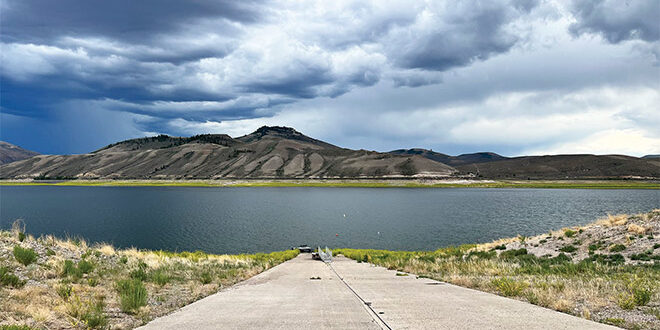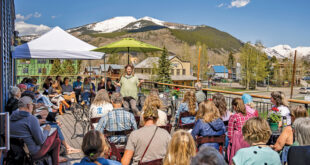In Colorado, water’s value and influence shouldn’t be underestimated
[ By Duane Vandenbusche ]
(This is the third of three parts of an abridged address by Dr. Duane Vandenbusche as part of his State Historian Address delivered in May of 2021. The address was given in 2021, but the situation is one that is pertinent today and into our future. —Mark Reaman)
Fast forward
By the 1950s, it was obvious that there was a great need for storage of water in the Upper Basin so it could deliver water to the Lower Basin when needed later in the year, after spring runoff. The Upper Basin also wanted storage of water for itself. This prompted Western Slope Congressman Wayne Aspinall, head of the House Interior and Insular Affairs Committee, to champion the Upper Colorado River Storage Act, which Congress passed in 1956. The act called for the building of six dams in the Upper Basin states—three on the Gunnison River: Blue Mesa, Morrow Point, and Crystal Dams—plus Navajo Dam on the San Juan River near Farmington, New Mexico, Flaming Gorge Dam on the Green River in Wyoming, and Glen Canyon Dam at Page, Arizona.
The act also called for the building of water projects for the Upper Basin to transport and make use of the stored water.
In the midst of increasing demand for water, population growth in Denver and along the Front Range on the east side of the Continental Divide led to controversial transmountain water diversions. The first major diversion was the Moffat Tunnel, which took water from the Fraser River on the Western Slope near Winter Park through a six-mile tunnel to Denver in the 1930s. The granddaddy of them all—the Colorado-Big Thompson Project—diverted water from the Colorado River at Grand Lake through the 13.3-mile Alva Adams Tunnel underneath Rocky Mountain National Park to Estes Park, and then down the Big Thompson River to communities along the northern Front Range. Built from 1938 to 1953, it cost $160 million and has the right to divert 310,000 acre-feet of water.
The Roberts Tunnel was another major diversion. Built from 1958 to 1962 by Denver Water, it took water from the Western Slope at the Dillon Reservoir near Silverthorne through a twenty-three-mile underground tunnel to a branch of the South Platte River near Grant on the Eastern Slope, ultimately allowing it to flow to Denver. The final major transmountain diversion was the Fryingpan-Arkansas Project, built from 1962 to 1974. This project diverted water from the Fryingpan River near Basalt on the Western Slope through the six-mile Boustead Tunnel into Turquoise Lake on the Eastern Slope and then down the Arkansas River into southeastern Colorado. All told, today in 2021, there are 38 transmountain diversions, taking 500,000 acre-feet of water from the Western Slope to the Eastern Slope of Colorado.
The water situation in Colorado and the West is dire. The West and Colorado are in the midst of one of the worst droughts in recorded history. The Colorado River is over-appropriated and there is not enough water to supply the 40 million people who depend on it. Mountain snowpack in the West has declined 15% in the last 20 years and Colorado River flows are down nearly 20%.
Much of Colorado, in the fall of 2021, is in what experts call “extreme drought.” The state’s water supply depends on three interconnected sources—snow, rivers, and groundwater—and all are in trouble. Fights over water in Colorado and the West today involve industry, agriculture, recreation, cities, environmentalists, power companies, the federal government, and land developers. We must accept the fact today that we live in an arid land—and act accordingly.
The day, I believe, is approaching when we will see “the Great Eastern Movement” when people have to leave Colorado and the West and move east where the water is. Former President Gerald Ford, talking about water in Colorado, once declared, “Education costs a lot but ignorance costs a lot more.”
The only thing that stops growth and more population in Colorado and the West is economics. When water bills rise to thousands of dollars a month, growth will stop. Many would like to live in Aspen or Vail, but with the price of a home in the millions, they can’t afford it. That analogy also applies to water. The Western Slope, where 80% of the water is, and the Eastern Slope which wants that water, will continue to fight for the precious liquid. The Western Slope view of the Front Range is colored by transmountain diversions of the past, while the Eastern Slope view is, “What’s mine is mine and what’s yours is negotiable.”
The major problem today regarding water is climate change. The National Research Council recently determined that the earth is the hottest it has been in 400 years. It declared, “Climate change and soaring population across the Southwest threatens to overwhelm the main water source for millions. The Colorado Basin is going to face costly, controversial, and unavoidable trade-off choices along with demands threatening the area’s ability to cope with droughts and water shortages.”
So, water truly is the lifeblood of Colorado—and there’s not enough of it. What does the future hold?
 The Crested Butte News Serving the Gunnison Valley since 1999
The Crested Butte News Serving the Gunnison Valley since 1999





